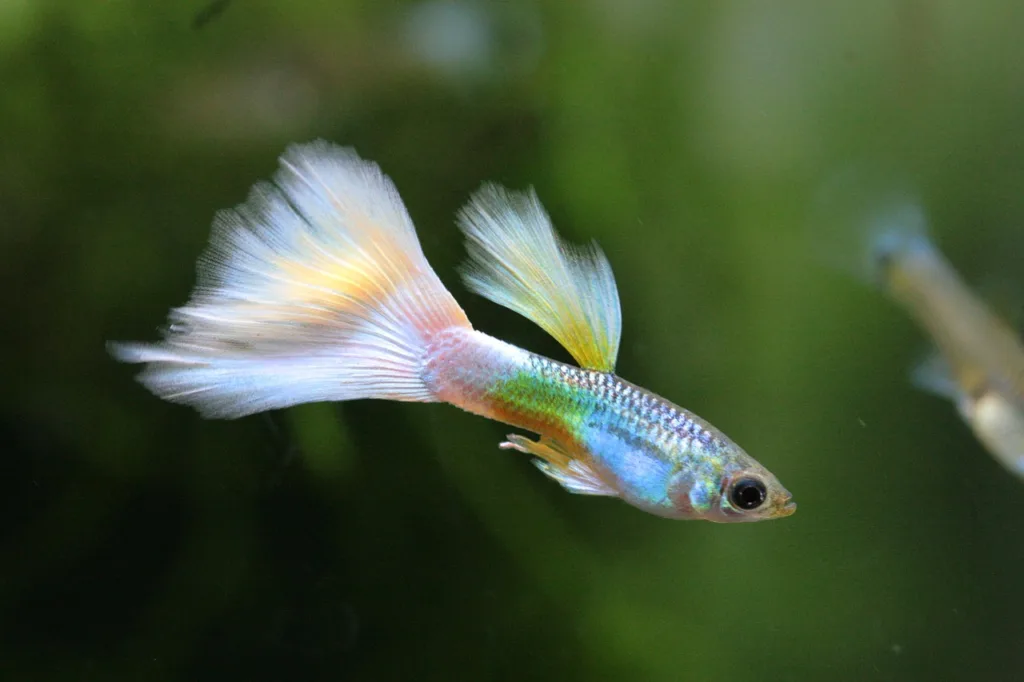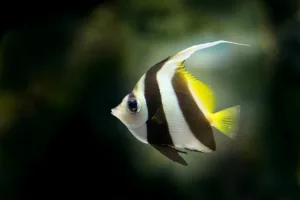Guppy fish tank cycling is a step that is often overlooked when beginners bring their first fish home from the store. However, to ensure the long-term health and well-being of your guppy fish, it’s crucial to understand and master the process of Guppy fish tank cycling. This article will guide you through the essential steps of guppy fish tank cycling, covering key concepts such as ammonia, nitrite, nitrate, beneficial bacteria, and the nitrogen cycle. We’ll also delve into guppy fish care, water quality, and aquarium maintenance, including fish tank cleaning and water changes.
The Nitrogen Cycle: Foundation of Fish Tank Cycling

Understanding the Nitrogen Cycle
The nitrogen cycle in Guppy Fish Tank Cycling is the cornerstone of a healthy aquarium ecosystem. It involves the conversion of harmful ammonia into less toxic substances through a series of biological processes. Here’s how it works:
- Ammonia (NH3): Ammonia is produced by fish waste, uneaten food, and decaying plant matter. It is highly toxic to fish and can be lethal in high concentrations.
- Beneficial Bacteria: Beneficial bacteria, primarily Nitrosomonas and Nitrobacter, play a vital role in the nitrogen cycle. These bacteria convert ammonia into nitrite and then into nitrate.
- Nitrite (NO2-): Nitrite is also toxic to fish but less so than ammonia. It is produced by the first group of beneficial bacteria (Nitrosomonas) as they break down ammonia.
- Nitrate (NO3-): Nitrate is the least toxic of these compounds and is mainly produced by the second group of beneficial bacteria (Nitrobacter) as they further break down nitrite.
Guppy fish tank water parameters
Maintaining proper water parameters in a guppy fish tank is essential for the health and well-being of your fish. Here’s a table summarizing the recommended water parameters for a guppy fish tank cycling:
| Parameter | Ideal Range for Guppy Fish | Acceptable Range |
|---|---|---|
| Temperature | 78-82°F (25.5-28°C) | 75-85°F (24-29.5°C) |
| pH Level | 7.0-7.8 | 6.5-8.5 |
| Ammonia (NH3) | 0 ppm (undetectable) | 0-0.25 ppm (minimal) |
| Nitrite (NO2-) | 0 ppm (undetectable) | <0.5 ppm (minimal) |
| Nitrate (NO3-) | <40 ppm | <80 ppm (with regular water changes) |
| Hardness (GH) | 8-12 dGH (moderately hard) | 6-16 dGH (soft to hard) |
| Alkalinity (KH) | 6-10 dKH (moderate alkalinity) | 4-15 dKH (low to high alkalinity) |
Temperature: Guppies thrive in tropical temperatures. Maintain a stable water temperature within the specified range to prevent stress and disease.
pH Level: Guppies are adaptable to a range of pH levels, but they typically do well in slightly alkaline to neutral water.
Ammonia (NH3): Ammonia should be kept at undetectable levels (0 ppm) as it is toxic to fish. Regularly monitor and address any ammonia spikes.
Nitrite (NO2-): Nitrite should also be maintained at undetectable levels (0 ppm). Elevated nitrite levels can harm fish.
Nitrate (NO3-): Keep nitrate levels below 40 ppm through regular water changes. High nitrate levels can lead to health issues for guppies.
Hardness (GH): Guppies prefer moderately hard water, but they can adapt to a range of hardness levels. Adjust water hardness as needed based on your specific guppy strain’s preferences.
Alkalinity (KH): Maintain moderate alkalinity to help stabilize pH levels in your aquarium.
It’s important to note that while these are the ideal parameters, guppies are adaptable fish, and they can tolerate some variations within the acceptable range. However, maintaining stable and suitable water conditions will contribute to the overall health, vitality, and coloration of your guppy fish. Regular water testing and adjustments as needed will help ensure a thriving guppy aquarium.
Fish Tank Setup: The First Step in Guppy Fish Tank Cycling
Before introducing guppy fish to your aquarium, ensure that you have your tank set up correctly. Here’s a checklist:
| Task | Details |
|---|---|
| Tank Selection | Choose a suitable tank size for guppies (at least 10 gallons). |
| Filtration System | Invest in a reliable filter to maintain water quality. |
| Substrate | Select a substrate (gravel or sand) for your tank’s bottom. |
| Heater | Use a heater to maintain a consistent water temperature (78-82°F). |
| Decorations and Plants | Provide hiding spots and plants for guppies to explore. |
| Water Conditioner | Use a water conditioner to remove chlorine and chloramines. |
| Cycling the Aquarium | Begin the nitrogen cycle process before adding fish. |
Guppy Fish Tank Cycling: Step by Step
1. Initial Ammonia Spike
When you set up your fish tank, there will be no beneficial bacteria to handle the waste produced by your guppies. As a result, you’ll experience an initial ammonia spike as ammonia levels rise. This can be harmful to your guppies if not managed properly.
Tip: To kickstart the cycling process, you can introduce a small amount of fish food or ammonia source (around 4 ppm) to simulate fish waste.
2. Beneficial Bacteria Colonization
Once ammonia levels rise, beneficial bacteria, mainly Nitrosomonas, will begin to colonize your aquarium’s surfaces, including the substrate, decorations, and filter media. These bacteria will convert ammonia into nitrite.
Tip: Monitor ammonia and nitrite levels regularly using test kits designed for freshwater aquariums.
3. Nitrite Accumulation
As beneficial bacteria work to convert ammonia, nitrite levels will increase. Nitrite is also toxic to fish, so it’s crucial to keep a close eye on these levels during the cycling process.
Tip: Avoid adding fish to the tank during this stage, as high nitrite levels can be harmful.
4. Nitrate Production
The final stage of the nitrogen cycle involves the conversion of nitrite into nitrate by beneficial bacteria, mainly Nitrobacter. Nitrate is less toxic than ammonia and nitrite, making it the least harmful nitrogen compound.
Tip: Once nitrate levels stabilize and ammonia and nitrite levels drop to zero, your tank is ready for guppy fish.
How to start the nitrogen cycle in your guppy fish tank
Starting the nitrogen cycle in your guppy fish tank is a crucial step to ensure a healthy and stable aquatic environment. There are several methods you can employ to initiate and facilitate the nitrogen cycle, each with its own advantages and considerations. Here are the primary ways to start the nitrogen cycle in your aquarium:
Fishless Cycling:
- Pure Ammonia: This method involves adding pure household ammonia (containing no additives like perfumes or detergents) to your aquarium to simulate the production of ammonia from fish waste. Start with a small dose, around 4 ppm, and monitor ammonia levels with a test kit. As the beneficial bacteria grow, they will gradually convert ammonia into nitrite and then into nitrate.
- Fish Food: Instead of pure ammonia, you can introduce small amounts of fish food into the tank. As the food decomposes, it will release ammonia, kickstarting the cycle. This method is less precise but is a more natural way to initiate cycling.
Seeded Media Method:
- If you have access to established filter media or substrate from a mature and healthy aquarium, you can introduce a portion of it into your new guppy tank’s filter or substrate. The beneficial bacteria present in the established media will quickly colonize the new tank, accelerating the cycling process.
- Tip: Ensure the donor tank is disease-free, as introducing pathogens can harm your guppy fish.
Commercial Bacterial Additives:
- Many aquarium supply stores offer commercial bacterial additives that contain beneficial bacteria strains. These products can be added to your aquarium to introduce the necessary bacteria to jumpstart the nitrogen cycle. Follow the manufacturer’s instructions for dosing.
Driftwood and Plants:
- Some aquarists use driftwood or live aquarium plants to help kickstart the cycle. These natural materials may carry beneficial bacteria that can aid in ammonia conversion. Be aware that this method may take longer to establish a stable cycle.
Established Substrate:
- If you have an established substrate from a cycled tank, you can use it as a base layer in your new tank. The substrate contains beneficial bacteria that will spread into the new environment and begin the cycling process.
Ammonia-Producing Fish:
- While not recommended for beginners, some experienced aquarists choose to cycle their tanks with hardy fish species that produce ammonia, such as zebrafish or danios. However, this method can be stressful for the fish and may not be the most humane option.
Important Considerations:
- Regardless of the method you choose, closely monitor water parameters throughout the cycling process. Regular testing for ammonia, nitrite, and nitrate levels is crucial to ensure that the cycle progresses smoothly.
- Be patient. The nitrogen cycle typically takes several weeks to complete. Rushing the process can lead to stress and health issues for your guppy fish.
- Avoid adding guppy fish to the tank until you consistently measure zero levels of ammonia and nitrite and detect the presence of nitrate. This indicates that the beneficial bacteria have successfully established and are actively processing waste.
Starting the nitrogen cycle in your guppy fish tank is a critical initial step in ensuring the long-term health and well-being of your fish. Choose the method that aligns with your experience level and resources, and always prioritize the welfare of your aquatic pets throughout the cycling process.
Maintaining Water Quality and Guppy Fish Care
Regular Testing
Maintaining proper water quality is essential for the health of your guppy fish. Regularly test your aquarium water for ammonia, nitrite, and nitrate levels. The goal is to keep ammonia and nitrite levels at zero and nitrate levels below 40 ppm.
Tip: Perform weekly water tests and record the results to track changes over time.
Fish Tank Cleaning
Fish tank cleaning is a vital aspect of aquarium maintenance. Here are some steps to keep your tank clean:
| Task | Frequency |
|---|---|
| Water Change | 20-25% every 1-2 weeks |
| Gravel Vacuuming | During water changes |
| Algae Removal | As needed |
| Filter Maintenance | Monthly |
Tip: Use a gravel vacuum to remove debris from the substrate during water changes Guppy Fish Tank Cycling.
Water Changes
Regular water changes are crucial for maintaining water quality and reducing nitrate levels. Aim for 20-25% water changes every 1-2 weeks. Use a dechlorinator when adding new water to remove harmful chlorine and chloramines in Guppy Fish Tank Cycling.
Tip: Match the temperature and pH of the new water to the aquarium’s existing conditions to avoid stressing your guppy fish.
Conclusion
In conclusion, understanding and mastering the art of guppy fish tank cycling is paramount for any freshwater fish enthusiast. The nitrogen cycle, often referred to as the backbone of aquarium maintenance, ensures a harmonious and healthy aquatic ecosystem for your guppy fish.
Throughout this article, we’ve explored various methods to initiate guppy fish tank cycling, including fishless cycling, seeded media, commercial bacterial additives, and more. Each of these approaches offers its unique advantages, allowing you to choose the one that aligns with your experience level and resources.
Proper guppy fish tank cycling is not only the foundation of a successful aquarium but also a commitment to the well-being of your aquatic pets. It sets the stage for maintaining optimal water quality, which, in turn, contributes to the vibrancy and longevity of your guppy fish.
Remember, patience is key during the guppy fish tank cycling process. Rushing it can lead to stress and health issues for your guppies. Regular monitoring of water parameters and adhering to the recommended water parameters for guppy fish are essential practices to ensure a thriving and sustainable aquatic environment.
So, whether you’re just starting your journey in freshwater fish keeping or looking to enhance your skills, always prioritize guppy fish tank cycling as the fundamental step to provide the best possible care for your beloved guppy fish.










